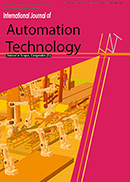Volume 17, Issue 3
Special Issue on Human Digital Twin Technology
Displaying 1-11 of 11 articles from this issue
- |<
- <
- 1
- >
- >|
Special Issue on Human Digital Twin Technology
-
Article type: Editorial
2023Volume 17Issue 3 Pages 205
Published: May 05, 2023
Released on J-STAGE: May 05, 2023
Download PDF (101K) -
Article type: Research Paper
2023Volume 17Issue 3 Pages 206-216
Published: May 05, 2023
Released on J-STAGE: May 05, 2023
Download PDF (2833K) -
Article type: Research Paper
2023Volume 17Issue 3 Pages 217-225
Published: May 05, 2023
Released on J-STAGE: May 05, 2023
Download PDF (871K) -
Article type: Research Paper
2023Volume 17Issue 3 Pages 226-236
Published: May 05, 2023
Released on J-STAGE: May 05, 2023
Download PDF (2241K) -
Article type: Research Paper
2023Volume 17Issue 3 Pages 237-247
Published: May 05, 2023
Released on J-STAGE: May 05, 2023
Download PDF (1161K) -
Article type: Research Paper
2023Volume 17Issue 3 Pages 248-261
Published: May 05, 2023
Released on J-STAGE: May 05, 2023
Download PDF (1990K) -
Article type: Research Paper
2023Volume 17Issue 3 Pages 262-276
Published: May 05, 2023
Released on J-STAGE: May 05, 2023
Download PDF (4610K) -
Article type: Research Paper
2023Volume 17Issue 3 Pages 277-283
Published: May 05, 2023
Released on J-STAGE: May 05, 2023
Download PDF (2651K) -
Article type: Review
2023Volume 17Issue 3 Pages 284-291
Published: May 05, 2023
Released on J-STAGE: May 05, 2023
Download PDF (1899K) -
Article type: Research Paper
2023Volume 17Issue 3 Pages 292-304
Published: May 05, 2023
Released on J-STAGE: May 05, 2023
Download PDF (5750K)
Regular Papers
-
Article type: Research Paper
2023Volume 17Issue 3 Pages 305-313
Published: May 05, 2023
Released on J-STAGE: May 05, 2023
Download PDF (2323K)
- |<
- <
- 1
- >
- >|
